2 The Science of Unitary Human Being: Beginnings
The Science of Unitary Human Beings 2.0
Howard K. Butcher
2.1 Introduction
In Rosemarie Parse’s (1994) tribute to Martha Rogers in Nursing Science Quarterly, she wrote that although Martha had moved on to another realm of the universe “her voice will not be silenced” (p.47). Her vision of nursing “energized the lives of nurses worldwide” and her “voice will echo through the ages” (p. 47). Nursing has endured in a significant way through her contributions to the discipline as she transformed nursing from a “prescience to a science” (Phillips, 1994, p. vi). This wiki-text is designed to assure that Martha Rogers’ voice continues to be heard by explicating the substance of her voice, message and vision. Rogers continues to have an immeasurable impact on the development of nursing as a scientific discipline. Dr. Martha Rogers, one of the most revered of 20th century nursing educators, became Professor and Head of the Division of Nursing at New York University in 1954 providing a generation of doctoral nursing candidates with a theoretical foundation for their profession.
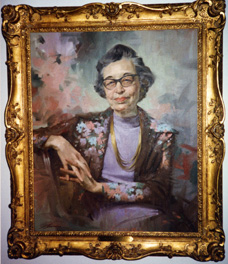
Martha E. Rogers by Portraits by Portraits, Inc 1976.
Photograph taken by Howard K. Butcher in 2002 at New York University and used with permission.
2.2 Early Experiences
Carl Jung (1952) wrote extensively about the nature of synchronicity which he described as a creative act, acausal parallelisms, and as unrelated events that have similar meanings. David Peat (1987) in his book “Synchronicity: The Bridge Between Matter and Mind” wrote that as acausal, meaningful, unique events involving some form of pattern, synchronicities in one’s life are often associated with periods of transformation like births, deaths, falling in love, intense creative work, and even a change in profession. “It is as if this internal restructuring produces external resonances” that create a burst of energy that propagates outward into the universe (Peat, 1987, p. 27). Synchronicities are manifestations that introduce meaning and value in an essential way into nature.
The fact that both Florence Nightingale and Martha Elizabeth Rogers share the same birth date, May 12, is one of the great synchronicities in nursing. Nightingale was born in 1820 and Rogers was born 94 years later in 1914, just four year after Nightingale’s passing. That Rogers shares the same birthday with Nightingale bursts forth with dynamic and deep meaning.
According to Rogers’ genealogy, her lineage can be traced Sir Geoffrey Luttrell who died in 1216. The Luttrells lived in Dunster Castle in Somerset, England for over 600 years. It was given to the UK National Trust in 1976. Rogers’ great-grandfather, James Luttrell, was a descendant of a James Luttrell who migrated to Maryland around 1667. Martha was named after her paternal grandmother, Martha Elizabeth Luttrell Rogers.
The Nightingales were a well educated, highly distinguished family whose main residence purchased by Nightingale’s father in 1825. Their majestic estate home was in the 4,000-acre Embley Park in near Romsey in the parish of Wellow, in Hampshire (Gill, 2004). The distance between Dunster Castle and Embley is about 94 miles.
 Dunster Castle
Dunster Castle
There are deep currents connecting Rogers to Nightingale. Like powerful waves rising from some deep undercurrent, both Nightingale and Rogers in similar ways did more to transform and propel nursing forward, both as a scientific discipline and as a profession, than anyone else. Rogers (1970) wrote that Nightingale “with unerring brilliance and deep human compassion . . . laid for nursing a foundation of far reaching significance” (p. x). In the 1992 Commemorative Edition of Nightingale’s Notes on Nursing: What It Is, and What It Is Not, Rogers contributed a chapter in which she clearly links her work to Nightingale. Other than Nightingale, no other nurse theorist has placed as much emphasis on the environment than Rogers. Rogers saw human beings as being integral or inseparable from their environment. Although Nightingale never used the term environment, she wrote about the importance of ventilation, air, sunlight, pure water, efficient drainage, warmth, diet, and quiet as elements that affect the health of those ill as well as those who are healthy. Both viewed health and illness, not as dichotomous conditions (Rogers, 1970, p. 125) but as on the same continuum. For example, Nightingale viewed disease as a reparative process in which the body strives for harmony while Rogers viewed both illness and well-being as manifestations of the same human-environmental mutual field process. Nightingale (1859) attempted to delineate the differences between what medicine does for a patient and what nursing does. She saw medicine as helping nature (the environment) to act and nursing as “putting the patient in the best position for nature to act upon him” (p. ). For Rogers, well-being is a symphonic mutual process of human and environmental fields. Both Nightingale and Rogers placed great emphasis on the uniqueness of nursing by stressing how nursing was distinct from medicine. Rogers often quoted Nightingale’s warning that “nursing and medicine should not be mixed up, it spoils both” (1992, p. 61). Both advocated for the use of noninvasive healing modalities; pressed for changes in public policy, political health reform; and set high scientific standards. Neither married, rather they dedicated their lives to nursing. They were powerful advocates for nursing education. Like Nightingale, Rogers viewed nursing as a learned profession. Nightingale felt “we should give the best training we could give any women of any class” (Nightingale, 1866) and launched the Nightingale training programs and schools for nurses. One hundred years later, Rogers called for an “educational revolution in nursing” that differentiated university education from vocational training and needed to be grounded in a systematized unique body of theoretical knowledge. She strongly advocated for graduate and doctoral education in nursing.
Dossey (1999) used the Myers-Briggs Type Indicator based on Jung’s descriptions of personality to analyze Nightingale’s letters, notes, and published works discovering that Nightingale was a INTJ (Introversion-Intuition-Thinking-Judging) personality type. This type is best described as being “original, visionary, private, independent, logical, critical, theoretical, systems-minded, firm, and demanding” (p. 427). In the many descriptions of Rogers’ personality, she most certainly manifested many of the same personality characteristics as Nightingale. Numerous personal accounts of Rogers’ personality have described her as being stimulating, challenging, idealistic, visionary, independent, family-oriented, humorous, academic, blunt, frank, hospitable, provocative, brilliant, radiant, feisty, willful, gentle, warm, vibrant, intellectual, philosophical, outspoken, radical, charismatic, creative, courageous, prophetic, avant-garde, outrageous, hard working, controversial, compassionate, generous, energetic, ethical, and yes, even ‘as crazy as a bedbug’ (Alligood, 1979; Butcher, 1999; Cheema, 1994; Hektor, 1989; King, 1994; Malinski, 1994; Mathwig, 1994; Parse, 1989; Pepper, 1989; Phillips, 1994).
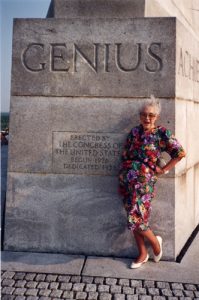
Martha E. Rogers in 1992 at the base of the Wright Brothers Monument at Kill Devil Hills near Nags Head, NC. Photo taken by Howard K. Butcher and used with permission.
In Gillian Gill’s (2004) book “Nightingales: The Extraordinary Upbringing and Curious Life of Miss Florence Nightingale,” Gill wrote that Florence was a remarkable student. She learned Latin with her father before she was eight and wrote letters to her parents in French and German by the age of 10. Her penmanship was remarkable and elegant and she was writing beautiful cursive by the age of 10. Florence’s father, WEN (William Edward Nightingale), took responsibility for the education of his daughters. As teenagers, Florence and her sister received an education “not only commensurate with their intelligence but comparable to that given to privileged young men in elite schools” (Gill, 2004, p. 119-120). Nightingale wrote “he taught me Latin and Greek and mathematics and whatever he knew himself. I had the most enormous desire of acquiring—for seven years of my life, I thought of little else but the cultivation of my intellect” (McDonald, 2001, Vol. 1. p. 90). In the Nightingale household, education was meant to train a person to think, to give a solid basis of fact, and to prepare for a professional life. WEN taught his daughters because he believed, rare for his time, that women too should be educated and he had the time. WEN “had an excellent mind and had received a superb education, first at a dissenting academy, then at Edinburgh, and then at Cambridge. WEN was one of the founding members of the British Association for the Advancement of Science. He expected the girls to work hard, taught them what he knew and then waited to see how they responded. He used a enlightened version of the standard school curriculum and was an engaged and loving teacher-father (Gill, 2004). Florence was a serious scholar. She studied Roman, French, German, Italian, and Turkish history as well as philosophy, ethics, grammar, composition, mathematics and the Bible (Dossey, 1999). She would awake early, between 4 AM and 6 AM to prepare for her daily lessons. She became fluent in Latin, Greek, French, German, and Italian.
Her father had a passion for books and was rich enough to afford a scholar’s library filled with not only the great classics, but modern poetry, fiction, philosophy, scientific monographs, and the best contemporary reviews that reported the latest findings in science, economics, public policy, and the newest fiction (Gill, 2004). Most importantly “Mr. Nightingale shared his books with his daughters” (Gill, 2004, p. 125). Florence was deeply grateful and proud of the extraordinary gift from her father and wrote in 1847 to her sister “I assure you I feel more and more everyday my gratitude to that father, who taught me all I ever knew, who gave me all the ideas I ever had, who taught me interest in nations as though they were personal existences, and showed me how to look upon all churches as but parts of the one great scheme, all opinions, political and religious, as but accidental developments of the one Parental Sap which comes up oats in one case and oranges in another. I do so feel, and gratefully acknowledge, the advantage of it now”(From Florence Nightingale in Room: Letters Written by Florence Nightingale in Room in the Winter of 1847-1848, Editor, Mary Keel (1981).
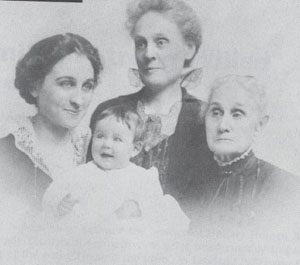
Four Generations, Left to right: Lucy K Rogers, mother; Martha E. Rogers; Laura B. Keener, grandmother; Lucy M. Brownlee, great-grandmother. From V. M. Malinski & E.A.M. Barrett (Eds.) (1994) Martha E. Rogers: Her life and her work. Philadelphia: F.A. Davis.
The parallels between Rogers and Nightingale are remarkable. The two major sources for descriptions of Rogers early life can be found in Malinski’s (1994) chapter titled “A family of Strong-Willed Women” and Hektor’s (1989) life history of Rogers. Both relied on first person accounts from Martha herself, as well as her sisters, nieces, and nephews. Martha E. Rogers was born on May 12, 1914 to Bruce Taylor Rogers and Lucy Mulholland Keener Rogers. Her father was in the insurance business. She was the oldest of four children, two sisters, Laura Rogers Wilhite and Jane Rogers Coleman, and a brother, Sam (nicknamed Keener). Jane stated that Martha being the first child and grand daughter received “all the attention and adoration” from her nearby aunts, uncles, and maternal grandparents (Malinski, 1994, p. 5). She was born in Dallas, TX, but the family moved to Knoxville, TN before she was a year old into a “sprawling old home on Yale Avenue” (Rogers quoted in Hektor, 1989, p. 12).
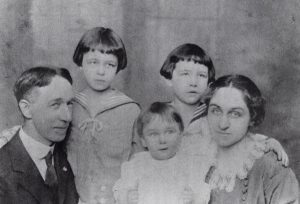
Bruce T. Rogers (Father), Martha,Keener (Brother),Laura (Sister),Lucy K. Rogers (Mother), From E.A.M. Barrett & V.M. Malinski (1994). Martha E. Rogers 80 Years of Excellence. New York, NY: Society of Rogerian Scholars, Inc., Press.
Rogers had a thirst for knowledge at an early age. She found Kindergarten to be “terribly exciting” (Rogers quoted in Hektor, 1989, p. 12) and had a love and passion for books that was fostered by her parents. Her father introduced her to the public library at the age of 3 where she loved story time (Reeder, 1994). “I liked to go off by myself with a book. By fourth grade, I had read every book in the school library. I used to go to the public library before I was 6. Even before I could read, I was well acquainted with the public library . . . Once I started reading I could check out eight books at a time—I went through the shelves, one after another. When I was in high school, my father was concern that I was ‘skimming,’ not really reading. So my father sat down to discuss the books I was reading I was reading with me and found I wasn’t skimming” (Rogers, quoted in Hektor. 1989. p. 13). Her father would sit with her and ask her to tell him what she had learned (Reeder, 1994). Like Nightingale, Rogers explained that there were “always loads of books in our home and in my grandparents’ homes . . . all kinds of books spilled all over . . . I knew the Greek alphabet by age 10. By the sixth grade, I read all 20 volumes of The Child’s Book of Knowledge and was into the Encyclopedia Britannica” (Rogers quoted in Hektor, 1989, p. 13). Martha’s niece, Katherine Lundy stated “for most years of her adult life, she rose at 5:00 or 5:30 AM and read—-her intention being to read at least five books a week (Lundy quoted in Malinski, 1994, p. 8). She loved to read anthropology, archaeology, cosmology, ethnography, astronomy, ethics, psychology, eastern philosophy, and aesthetics (Reeder, 1994). “She loved to read because it made her stop and think” (Reeder, 1994, p. 319). By her senior year she had completed all the high school math courses and was taking a college level algebra course where she was the only female in the class.
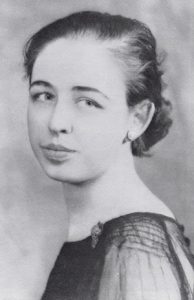
Martha E. Rogers in her teens from From E.A.M. Barrett & V.M. Malinski (1994). Martha E. Rogers 80 Years of Excellence. New York, NY: Society of Rogerian Scholars, Inc., Press.
2.3 Pursuit of Education
When asked by Safier (1977) why she went into nursing Martha said, “the reasons are generally complex—but I had a great missionary zeal when I was in high school. I wanted to do something that would, hopefully contribute to social welfare. I loved law and medicine. When I entered college, not being sure, I tossed a coin and it came out medicine. So I studied science–med for a couple of years. But women in medicine were not particularly desirable animals in those days, my parents thought it was rather inappropriate career for a female. The local hospital had a school of nursing, and a friend of mine had decided she would enter there in September, so I decided to go along. My parents weren’t really any happier over that decision than they had between over medicine” (p. 319). She stated “perhaps I should have selected home economics like my two sisters” (quoted in Safier, 1977, p. 319). From 1931 to 1933 Rogers took premed courses at the University of Tennessee at Knoxville. She states “I took zoology, genetics, embryology and many other course” (Hektor, 1989). It is interesting to note that both Nightingale and Rogers defied their parents’ wishes to pursue their careers. Nightingale told no one in her family of her plans (Gill, 2004, p. 193). In 1845 she secretly made plans to train as a nurse in a public hospital, the Salisbury Infirmary, and then perhaps start a Protestant sisterhood dedicated to the care of the indigent sick (Gill, 2004, p. 190). When her parents and sister found out her plans to pursue her dreams of hospital nursing, they were in fact “horrified” (p. 195).
In September of 1933 Rogers transferred into Knoxville General Hospital’s nursing program and was one of 25 students in her class. She described her training as at times as being miserable because the training was like the “Army, pre-Nightingale. You had to stand up for everyone; it really wasn’t for me.” (Hektor, 1989). She even spent a week at home, thinking of not returning to school but then noticed all the “tired people, working class people . . . so I went back” (Hektor, 1989). In a interview with Safier she said “I really couldn’t come up with anything better so I went back” (p. 320). Reeder (1994) stated Rogers returned to school because she wanted to know why the poor working class people had no zest for life and because nursing held the promise to help people. She distinguished herself there by starting a library at the school of nursing. She states she enjoyed working with people and patients. According to her vitae, she graduated in with a diploma in 1936, but her parents were still not happy that she did not have a degree, so Rogers entered college and went on to earn a Bachelor of Science degree in Public Health Nursing from George Peabody College in Nashville in 1937. After she graduated she worked for the Children’s Fund of Michigan for two years as public health nurse. She went to central Michigan “because I wanted to travel, see the world.” The position was recommended by the Director of the program at Peabody College. Her work involved home visits, case finding, giving vaccinations, planning and giving health teaching programs, and committee work. “I liked seeing people where they were in their home” (quoted in Hektor, 1989, p.15).
She decided in 1939 to return to school. “I liked going to school: I knew I didn’t know enough.” She sold her car to pay for tuition and entered a Masters degree program full-time at Columbia’s Teacher’s College in New York City Her father died of cancer two months before she started classes but “he insisted that I go ahead with my plan to return to school” (quoted in Hektor, 1989, p. 16). After two semesters, in 1940, Rogers accepted a position in Hartford, CT at the Visiting Nurse Association. She worked at the Association for five years, first as an Assistant Supervisor, then as the Assistant Education Director, and lastly as the acting Director of Education. At the same time she was completing her course work at Teacher’s College and completed her degree requirements (Master of Arts) in 1945. Notably, Rogers stated about her work in Hartford, “I thought nursing was a knowledgeable endeavor, and that nurses should be baccalaureate prepared and more. We exercised freedom and autonomy. We were responsible for our own acts. We were never accountable to other disciplines; that accountability would have jeopardized our autonomous position” (p. 16).
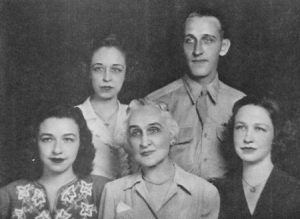
Rogers Family, circa 1945. Jane L. Coleman, Martha E. Rogers, Lucy K. Rogers, (Mother) Keener (Brother), Laura B. Whilhite (sister) from E.A.M. Barrett & V.M. Malinski (1994). Martha E. Rogers 80 Years of Excellence. New York, NY: Society of Rogerian Scholars, Inc. Press.
After completing her degree in 1945 she sent out a number of job inquiry letters, considered staying in Hartford, but settled on a position as the Executive Director at the Visiting Nurse Service in Phoenix, Arizona. She believed she may have been the first nurse in Arizona with a masters degree and for six years (1945-1951) she built up the Visiting Nursing Service in Phoenix. “I loved everything about those years” and in the last years of her life she returned to Arizona where she stayed for the rest of her life.
“I didn’t know enough . . . I had too many questions” so she returned to school in 1945. (Hektor, 1989, 18). She decided to enter the top public health program in the US, John Hopkins University in Baltimore. Maryland in 1951. There were few Master in Public Health (MPH) at the time. She finished the degree in a year (1952), her second masters degree, and right on into their doctoral program, earning a doctor of science degree (ScD). The program had the same requirements as the PhD, and she completed a wide range of course work including studies in biology and statistics. She commented on the fun she had being engaged in “all kinds of interdisciplinary discussions.” She engaged in full-time studies and felt being a full-time student allowed her to engage more deeply in her studies and interactions with others. While a doctoral student, she spent a year as a visiting lecturer at Catholic University in Washington, DC. She completed her studies in 1954 and the title of her dissertation was “The Association of Maternal and Fetal Factors with the Development of Behavior Problems Among Elementary School Children.” Graduating in 1954 from John Hopkins University, Rogers was among a very select group, becoming one of the few nurses at that time to hold a doctoral degree.
2.4 Building a Scientific Discipline
The first nursing doctorate was established in 1924 at Teachers College, Columbia University. Nurses were awarded the EdD degree in this program that focused on preparation of teachers of nursing and the needs of nursing leaders. New York University offered the first nursing PhD in 1934. In the 1950’s, the University of Pittsburgh’s nursing PhD program in Maternal and Child Nursing emphasized the importance of clinical research to the advancement of nursing’s body of knowledge and the profession of nursing. Boston University’s nursing doctoral model, the doctor of nursing science (DNSc), was unique in that their degree was the first to focus on the nurse as a professional practitioner in the role of providing nursing care. Some nursing leaders quickly adopted this as the minimal degree for entry into practice, as they did not feel that the traditional 4-year baccalaureate degree adequately prepared nurses for practice at the bedside. By the 1950’s, nursing had created 3 unique models for doctoral education. This was the beginning of the controversy surrounding nursing doctoral degrees that continues today.
Martha Rogers was appointed Professor and Head of the Division of Nursing at New York University right after graduating from Hopkins. She was encouraged to accept the position by Ruth Freeman, who six years later would write the Forward for Rogers’ first book, “Educational Revolution in Nursing” (1961). Freeman, considered among the most outstanding leaders in public health nursing, wrote that Rogers in this “provocative book . . . evolves a conceptualization of the kind of education needed to realize the potential of nursing for human betterment” and “explores the meaning and nature of nursing and its relation to the broad sweep of human values and knowledge” (p. v). Freeman earned her Ed.D. in 1951 from New York University and was on the faculty at the School of Hygiene and Public Health at Hopkins at the time Martha was completing her doctoral studies.
When Rogers arrived at NYU, Vera Fry was the previous Division Head and Joan Hoexter stated that all of the nursing faculty except her left.
2.5 Constructing a Discipline and Science
Rogers noted the lack of nursing-specific content in the curriculum. She raised concerns about the emphasis on technical skills and pointed out that on “there is no need to go to college to learn technical skills” (M. Rogers, June 29, 1988 quoted in Hektor, 1989). Rogers repeatedly stated that nursing was a learned profession. She felt there was not an adequate focus substantive nursing knowledge, and guided a curriculum revision that placed emphasis on human beings rather than simply function. She added statistics and later physics to the curriculum at all levels. one of her famous quotes was the one below, published in 1966 in an NYU publication called “The Education Violet” where she described the essence of nursing.
“Nursing’s story is a magnificent epic of service to mankind. It is about people: how they are born, and live and die; in health and in sickness; in joy and in sorrow. Its mission is the translation of knowledge into human service. Nursing is compassionate concern for human beings. It is the heart that understands and the hand that soothes. it is the intellect that synthesizes many learnings into meaningful administrations. For students of nursing and the future is a rich repository of far-flung opportunities around this planet and toward the further reaches of man’s explorations of new worlds and new ideas. Theirs is the promise of deep satisfaction in a field long dedicated to serving the health needs of people.”
Professor Martha Rogers, Ph.D., RN.
The Education Violet, June 1966
New York University
The quote has often been reprinted on handouts given conferences hosted by the Society of Rogerian Scholars. Professors who were recruited to NYU like Jean Mathwig, RN; PhD and Joan Hoexter, RN; PhD, the only faculty member who remained after Dr. Rogers became Dean, described the early years as a time of great “enthusiasm” among students, described Martha as a “marvelous seminar leader” and she was “always creative and supportive.” Mathwig stated that “Martha was brilliant, avant guard” that they all “laughed a lot” but worked hard. Often the faculty met outside of work to continue to talk and plan program and curriculum changes (Hektor, 1989).
Rogers’ ideas took shape in first book, “Educational Revolution in Nursing” published 1961. Ruth Freeman wrote in the book’s forward that “Dr. Rogers’ influence on nursing appears in many guises–her work as director of one of the largest nursing education programs in the country, in her too infrequent publications, in her many contributions to organizational activity (p. v).” Freeman described the book as “provocative,” a book that should stimulate thinking what nursing education is and should be. The book begins by differentiating “vocational”, “technical”, or associate degree nursing education from “professional” or university-based education, which she asserted are different in their objectives, requirements, teaching approach, and faculty preparation. She believed that university-based education was required for professional nursing practice, and in the book laid out the basic content of baccalaureate nursing education. She stated clearly “the term, professional nurse, must be reserved for those who possess a broad foundation of liberal arts; biological, physical and social sciences, and upper division nursing theory provided in and controlled by a college or university” (p. 52). Theoretical learning would take place in classrooms and clinical study in regularly scheduled laboratory periods where the student tests and affirms theoretical learning. “Field practice” Rogers asserted, “is not the equivalent of a college course” (p. 35) and the “number of hours spent in the laboratory setting is no indication of the amount of learning that takes place” (p. 35). Graduate education was for clinical specialization, an opportunity for more knowledge and preparation for responsible leadership. The doctoral level should be preparation for consultation and research. Research in nursing is focused on “the study of man and his environment–the inevitable interaction and the dynamic interchange of forces that constitute an integral part of man’s evolution through space and time” (Rogers, 1961, p. 44).” Only nurses do nursing research” (p. 45).
The university-educated professional nurse, Rogers (1961) asserted, “stands at the center of the educational continuum” (p. 10) and their preparation requires “substantial knowledge in liberal arts, biological, physical, and social sciences, and nursing theory.
Rogers strongly believed in a broad and rigorous preparation for professional nursing practice.” Colleges and universities provide the theoretical knowledge and basic principles essential to professional practice” (p. 35). Without a foundation in liberal arts, Rogers stated, one cannot move on to the additional knowledges that are significant to nursing. To understand oneself and the world around them one must have a broad liberal arts foundation. “Nursing is concerned with human beings” (p. 32) and therefore nurses need a broad understanding of human beings and their world. Thus, Rogers goes on to lay out a nursing curriculum that includes courses in math, foreign languages, logic, philosophy, biology, microbiology, physics, chemistry, psychology, sociology, literature, music and art. Courses in anatomy, physiology, histology, genetics, biophysics, biochemistry, biostatistics, epidemiology, history, economics, political science, nursing philosophy, and nursing theory are all seen by Rogers as foundational to professional nursing practice. “The synthesis of these broad areas concerned with the life process must replace the segmented, disease-oriented approach, geared to memorization of multiple, finite details and technical skills” (p. 37). Nursing theory “must be taught by nurse faculty members who possess a considerably broader foundation than that which students will bring to nursing courses (p. 38). Faculty she believed needed to be well informed in the theoretical content of the discipline, and a sizable number of faculty should have the knowledge and tools to develop nursing theory. Nursing theory at this time was just beginning to evolve, Peplau published her book in 1952, Johnson published her “philosophy of nursing” in 1959, and Henderson published her basic principles of nursing care in 1960. It would be another 10 years before nursing theories began to evolve with the writings of Orem, Roy, King, Levine, and Newman all first emerging in the early 1970’s.
Nursing education needs to be designed to prepare nurses for the future, and she felt “yesterday’s methods will not suffice for tomorrow’s needs” (p. 33). Nursing education cannot be substituted for liberal education, rather “liberal must be fused with it” (p. 34). Rogers goes on to say that nursing graduates work with people in a variety of settings for the purpose of promoting health, preventing disease and disability, evaluating human progress, and implementing intervention for habilitation and rehabilitation (p. 38). These ideas continued to evolve over time, and the language she used changed substantially as her views on the Science of Unitary Human Beings evolved.
2.6 Evolution of the Science of Unitary Human Beings
The evolution of the Science of Unitary Human Beings can be understood as a process consisting of four distinct phases, or what I will refer to as five (5) unitary transformations. The first unitary transformation, “emergence,” occurred when Rogers (1961) first published her ideas in Chapter 2 in “Education Revolution in Nursing” and extended her theoretical ideas in her second book Reveille in Nursing (Rogers, 1964). Rogers also articulated her emerging theoretical system in a paper presented at the Annual Conference on Research and Nursing at Teachers College. In the presentation Rogers (1967) laid out what would later become her four postulates. The second unitary transformation, “synthesis,” occurred with the publication of the 1970 landmark book, “An Introduction to the Theoretical Basis of Nursing.” The third unitary transformation which I will refer as “formation,” first appeared in 1983 as a handout titled “The Science of Unitary Human Beings: A Paradigm for Nursing” and published in a lesser known publication, a monograph titled “Examining the Cultural Implication of Martha Rogers’ Science of Unitary Human Beings” published by Wood-Kekahbah Associates (1985). Rogers would distribute it at her presentations with the date 1983 and it was fully formed in Rogers’ 1988 publication “Nursing Science and Art: A Prospective in Nursing Science Quarterly. The fourth unitary transformation, “extension” is ongoing. It originated in the works of Rogerian Scholars who continue to develop new “structures” such as practice and research methodologies, new concepts, and new theories derived from Rogers’ postulates and principles. Specifically, the work of Elizabeth Barrett, Richard Cowling, Howard Butcher, and John Phillips are representative forces in the extension unitary transformation. This work, this wiki text is also representative of this fourth transformation, but began in earnest with Elizabeth Barrett’s work on the Power as Knowing Participation in Change theory and her articulation of the first Rogerian practice model (Barrett, 1988). Could we be on the cusp of the fifth unitary transformation? I have tentatively named this next transformation “crystallization,” in which the essence of the Science of Unitary Human Beings reaches full clarity and maturity of meaning and understanding, and shines brightly amidst the kaleidoscope of nursing knowledge. Can this text, this comprehensive explication of the Science of Unitary Human Beings usher us into this next and fifth unitary transformation?
A “unitary transformation” is characterized as a leap in development, a quantum jump from one level of theoretical organization to a new level of theoretical organization. Each unitary transformation emerged because a new mass of scientific and theoretical knowledge was added to the scientific system, like a new ingredient to cake batter, and through a process of resynthesis, a new understanding of the Science of Unitary Human Beings emerges. New concepts are named and defined, old concepts are refined and clarified. New understandings of the Science of Unitary Human Beings are articulated with each transformation; one understanding dissolves and a new understanding emerges anew.
2.7: Unitary Transformation: Emergence
The first unitary transformation “emergence” first appears on pages 18-19 in Educational Revolution in Nursing (Rogers, 1961). While Rogers held the understandings years previously, they were not in print for wide dissemination until they appeared in the 1961 text.
Rogers asserted that the study of nursing requires concepts and theories (Rogers, 1961, p. 45). Theories useful to nursing may also be useful to other disciplines, just as theories from other disciplines are useful to nursing. In Chapter 2, Rogers begins her first rendition of her thoughts for the development of her nursing theory. She asks “What is man, Where does he fit in the universe, what is life, how can man be conceptualized, consistent with the world as we know it”(p. 16)?. She goes on to ask “is life a manifestation of energy” (p. 17)?
Rogers stated in an interview with Lynne Hektor that she needed a book to teach nursing as a science and she began her writing in the 1960’s. Her ideas, she stated came from a “lifetime of reading, teaching, teachers, students, and other faculty” (Rogers quoted by Hektor, 1989). She explained she had been” living with those ideas for awhile, moving into a new world view.” The first image of a Slinky like model in her theoretical work appears on page 20 in Educational Revolution in Nursing in a figure titled “Schematic Interpretation of Man in the Universe.” The Figure as first presented looks like a helix, a “expanding spiral of life in an expanding universe” from the infinite past to an infinite future. The evolution is depicted as evolving through time and space. The spiral of life is surrounded by an “expanding universe.” By 1970 the helix image was replaced by a Slinky like spiral. Later she would say the Slinky was just an aid thinking . . . the Slinky signified open-mindedness and non-repeating rhythmicities” (Rogers quoted in Rogers, Doyle, Racolin, & Walsh, 1994). I recall Rogers saying once that the idea of the Slinky came from a suggestion by a student in a class she was teaching about the science of man.
There are remarkably few references in the text, however there is an extensive bibliography at the end of the book. Most of the sources focus on the educational content, few are listed for the scientific content presented in Chapter 2. However, there are references to modern physics, quantum physics, energy as a life process, life processes, humanism, and ethics.
There are three postulates stated in this first explication of what was to evolve into the science of unitary human being. Each postulate started with a set of “underlying factors.”
First Postulate: “Through time and space man’s continuous interaction with the universe moves him toward and away from multiple potential states of equilibrium” (Rogers, 1961, p. 18). This postulate is supported by 9 “factors” such as: “man is an integral part of the universe; the universe is continuously changing; and man’s position, with respect to equilibrium, will vary according to space and time” (p. 18).
Second Postulate: “Man can initiate change and predict the subsequent series of changes within the limits of his own knowledge and dynamic universe.” (Rogers, 1961, p. 19). Among the 3 of the 5 supporting factors for the second postulate listed were; “man is subject to the laws of the physical, biological, and social worlds; these laws describe a dynamic universe; and when man initiates change, he sets off a series of changes” (p. 19)
The Third Postulate was stated as: ‘Man is uniquely able to unite past, present, and future in adaption to and changing with an evolving universe” (Rogers, 1961, p. 19). Some of the underlying factors included were “man’s evolution is an expression of a dynamic universe” and “man’s capacity to transmit culture differentiates him from the rest of the biological world” (p. 19).
It is important to note that, in this and other early writings, Rogers used language and concepts that were rooted in an old worldview, which later she considered inconsistent with the “new worldview” emerging in contemporary science. Concepts such as adaptation, equilibrium, disequilibrium, interaction, states, man (later updated to human beings), diagnosis, intervention and predict were terms used in Rogers’ first renderings of her model. Such it is with each unitary transformation, a entirely new system of thought, building on the previous one, emerges as Rogers synthesizes new knowledge from a wide range of contemporary scientific theories. These new theories were embedded in a new paradigm, a new view grounded in an open systems view of the universe and of life.
However, one can see in these three early postulates the roots of Rogers’ vision of the Science of Unitary Human Beings that took shape in the the 1980’s. Rogers’ view of a “dynamic universe,” “constant change,” “potentialities,” “interaction” (later replaced by the idea as a mutual process), “space and time,” and “evolution” were ideas that are foundation to the Science of Unitary Human Beings. By the 1980’s, Rogers considered adaption, equilibrium, causality, and predictability as outdated views, and she replaced these concepts with new emerging ideas and concepts consistent with an open systems negentropic perspective of the universe. The new ideas that transformed the Science of Unitary Human Beings transformed concepts such as casualty and interaction into concepts such as “mutual process” and “simultaneous change.” Notions of cause and effect were replaced new understandings of change such as nonlinearity, unpredictable, and randomness emerging from contemporary physics. Ideas such as “states,” “equilibrium and “adaptation” evolved into the ideas of “continuous change,” “mutual process,” and “homeodynamics.” These concepts and ideas are explored later in this Chapter and in Chapters 4 and 5.
Perhaps Rogers took Freeman’s “infrequent publications” (p. v) comment in the preface of Educational Revolution in Nursing to heart, because only three years later Rogers published her second book, “Reveille in Nursing” in 1964.
Rogers’ main motivation for developing a theoretical system is asserted again in Reveille. Rogers’ (1964) states the purpose of the book is to set forth “an approach to the development of undergraduate professional education consistent with the philosophy and purposes of higher learning and professional education” (p. 12). More importantly, “professional education requires rigorous intellectual training. A body of abstract principles, the product of scientific research and logical analysis, is indispensable to its being” (p. 32).
While Rogers does not explicitly build on the three postulates she first presented in her first book, there are several core ideas she she lays out in this volume that later become core to the Science of Unitary Human Beings.
First, Rogers repeatedly states that nursing is a “learned profession.” As a learned profession, nursing is responsible to the society nurses serve, and the serve that nurses provide, is unique. The uniqueness of the service of nursing “lies firmly in the body of knowledge that defines nursing’s scope” (p. 44).
Second, she states “man is at the center of nursing’s purpose” (p.36), and she goes on to say for the first time “man is more and different from the sum of parts” (36-37).
Third, man is in a process of dynamic becoming.
Fourth, for the first time, she describes man as a complex electrodynamic field. While the idea of energy field as a electrodynamic field persisted in her 1970 book, it is important to state, she later clarified this idea by stating that the concept of energy field in not simply a physical field or electrodynamic field, rather the term energy signified the dynamic nature of the field.
Fifth, man is an open system constantly being “shaped” by the environment through a continuous with nature and other parts of the universe.
Rogers (1964) does not provide any explanation or foundation for these statements, but they later become central postulates in her landmark 1970 book, where she clarifies and expands the meaning of these the major postulates by providing substantial supporting evidence.
The main focus of Reveille is on nursing education, and not the emerging theoretical system. In the text, she goes on to say, the text is not a substitute for the background knowledge readers need for designing nursing curriculum, nor a blueprint for action, rather the text is designed to provide a vision, “a clearer frame of reference, be a “stimulus for further imaginative development of undergraduate curriculums” (p. 12-13).
Several enduring themes first introduced in Educational Revolution in Nursing are further advanced, such as: 1) experience is not a substitute for formal learning; 2) professional nursing education needs to be situated in institutions of higher learning; 3) professional nursing needs to build upon a broad liberal arts, natural and social science foundation so that nurses have an understanding of human relationships; 3) nursing courses represent only a portion of courses taught at an upper division; 4) associate degree programs are not the equivalent to university education programs and do not adequately prepare nurses for a professional level of practice, rather associate degree prepare “technical” nurses;” 5) the uniqueness of a discipline is grounded the discipline’s body of knowledge, not in technical and practical skills; 6) nursing education needs to be grounded in nursing science; 7) nursing is a basic science, not an applied science.
Rogers’ visionary thinking is evident throughout Reveille. She refers to the importance of “space technology,”(p.8) and “space exploration,”(p.7), “bionics”(p. 8), living in an electronic world” (p. 8), big data [“automated equipment is busy collecting, processing, and retrieving data”] “vast amounts of correlated data” (p. 8).
One needs to be reminded, Rogers is writing about these futuristic changes in 1964, the point being, nurses need to be educated to be prepared for the future. In fact, the first lines in Reveille starts with “rapid and unprecedented scientific advances, technology leap frogging, and socio-cultural change coupled with a growing sense of social responsibility for human welfare are creating new and expanding demands for health services and health personnel” (p.1). Rogers’ situates nursing within this “period of sweeping transition” (p. 2) and “nursing cannot escape the molding forces of our age” (p. 7).
2.8 Unitary Transformation: Synthesis
2.9 Unitary Transformation: Formation
Endings and Beginnings
High in the heavens, in the northern night sky, one can easily distinguish the pattern of stars that form the constellation Ursa Major. Ursa Major, or “The Great Bear,” is unmistakably visible because the well-known “Big Dipper” forms the bear’s tail section. Ursa Major, the third largest constellation, is also distinctive because seven bright, second magnitude and third magnitude stars form the Big Dipper (Kerrod, 1993).
In addition, the nearby constellation Ursa Minor (Lesser Bear) includes the North Star (Polaris) (Croswell, 2001). The North Star marks the celestial North Pole. Therefore, it does not move in the sky; rather all stars rotate around the North Star. The North Star is a great beacon of light giving direction to lost navigators and lost souls. In Ursa Major, there is also a star (RA 9h 33m 56s D 48° 9′) named after Martha E. Rogers. This star is an enduring symbol of the luminous glow of her life and contribution to nursing serving as a beacon illuminating all that nursing is and aspires to be.
The following Poem by anonymous was published “In Memoriam” Martha E. Rogers (1914-1994) in the Summer 1994 issue of Nursing Science Quarterly.
Do not stand at my grave and weep,
I am not there, I do not sleep.
I am a thousand winds that blow;
I am the the diamond glints on snow;
I am the sunlight on ripened grain;
I am the gentle autumn’s rain.
When you awaken in the morning’s hush,
I am the swift uplifting rush
Of quiet birds in circled flight.
I am the soft star that shines at night.
Do not stand at my grave and cry.
I am not there; I did not die.
-anonymous
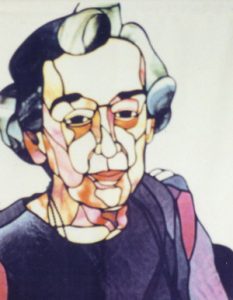
A Section of the Stained Glass Window of Martha E. Rogers. Photograph taken by Howard K. Butcher (1990) and used with permission. Currently archived at the “Center For Nursing: Curating the Past, Cultivating the Present, Crafting the Future” Foundation of New York State Nurses, Inc Center for Nursing at https://www.foundationnysnurses.org
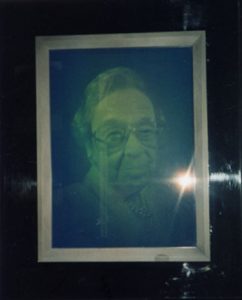
Hologram of Martha E. Rogers (Portrait by Ana Maria Nicholson, 1992). Photograph taken by Howard K. Butcher and used with permission. Currently archived at the “Center For Nursing: Curating the Past, Cultivating the Present, Crafting the Future” Foundation of New York State Nurses, Inc Center for Nursing at https://www.foundationnysnurses.org
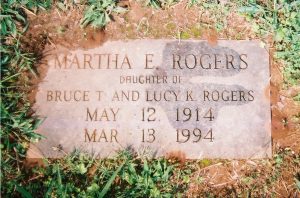
Martha E. Rogers’ Gravesite in Knoxville, TN
1.8 References to be added
